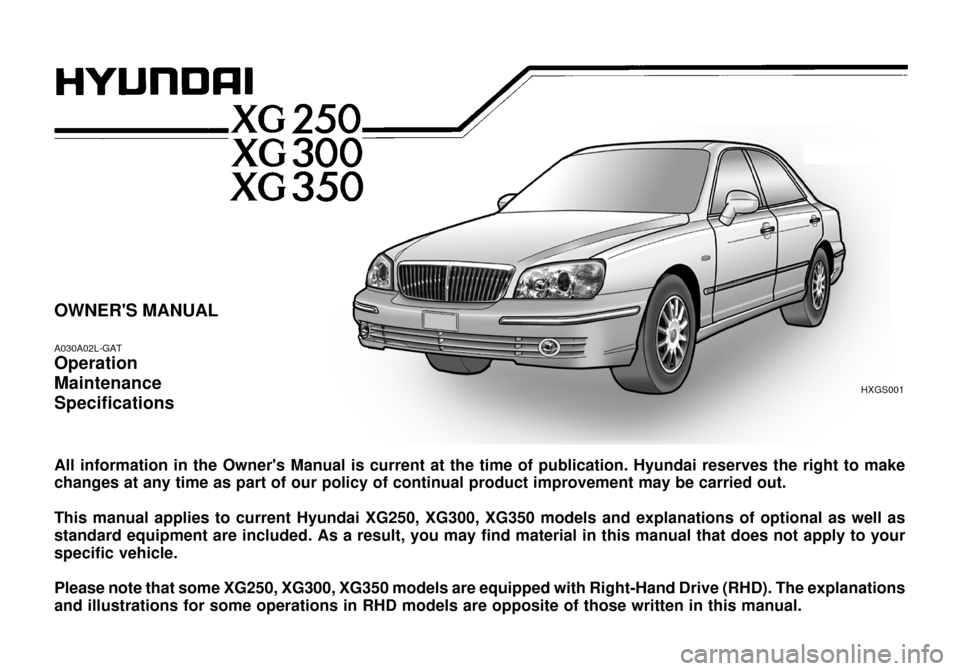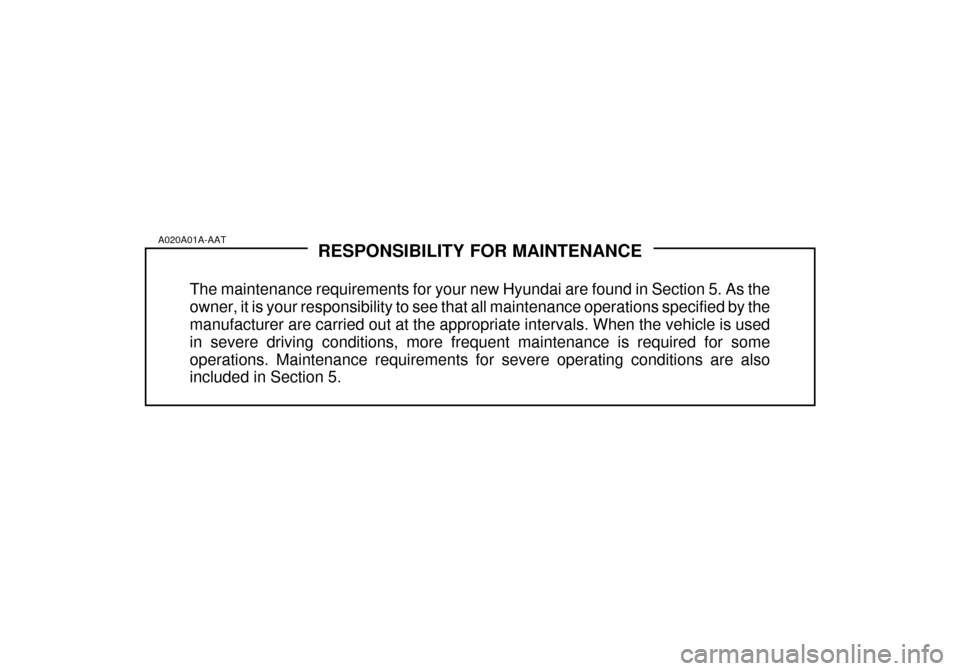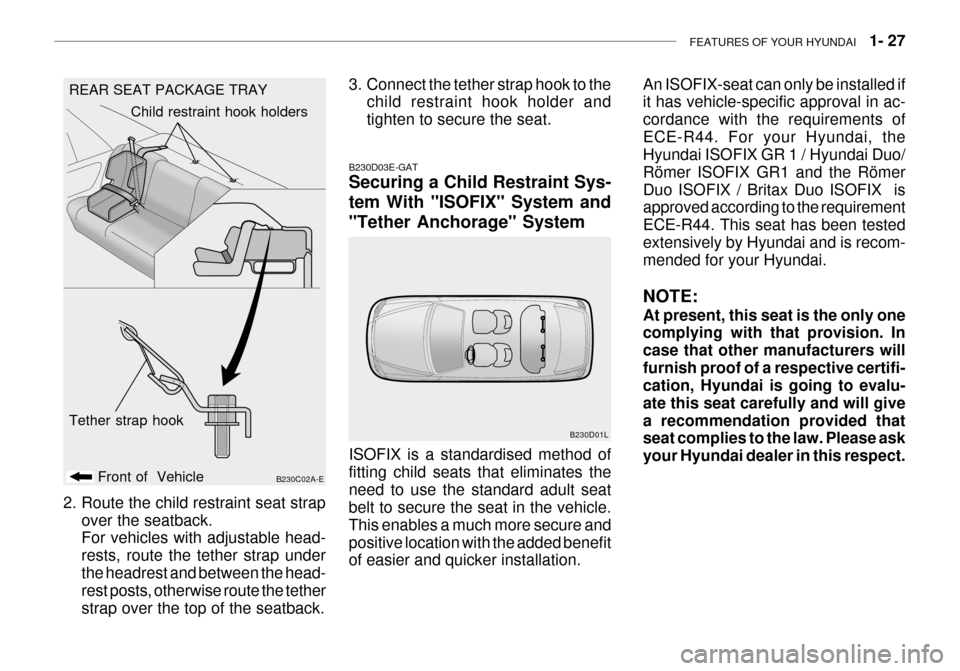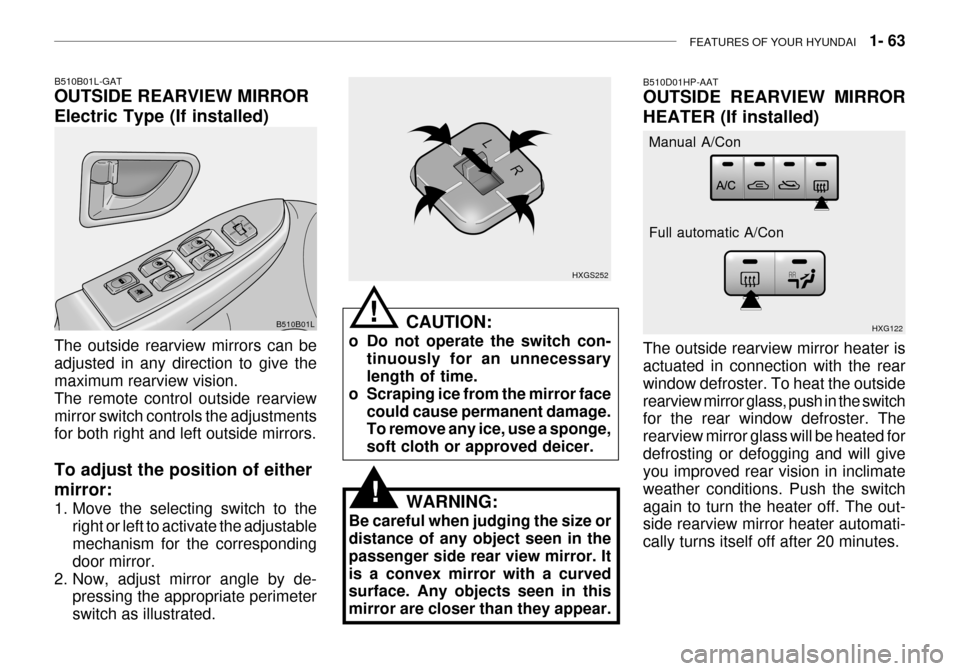ESP Hyundai Grandeur 2003 Owner's Manual
[x] Cancel search | Manufacturer: HYUNDAI, Model Year: 2003, Model line: Grandeur, Model: Hyundai Grandeur 2003Pages: 235, PDF Size: 14.25 MB
Page 3 of 235

OWNER'S MANUAL A030A02L-GAT Operation MaintenanceSpecifications All information in the Owner's Manual is current at the time of publication. Hyundai reserves the right to make changes at any time as part of our policy of continual product improvement may be carried out. This manual applies to current Hyundai XG250, XG300, XG350 models and explanations of optional as well as standard equipment are included. As a result, you may find material in this manual that does not apply to your specific vehicle. Please note that some XG250, XG300, XG350 models are equipped with Right-Hand Drive (RHD). The explanations and illustrations for some operations in RHD models are opposite of those written in this manual.
HXGS001
Page 4 of 235

RESPONSIBILITY FOR MAINTENANCE
The maintenance requirements for your new Hyundai are found in Section 5. As the owner, it is your responsibility to see that all maintenance operations specified by themanufacturer are carried out at the appropriate intervals. When the vehicle is used in severe driving conditions, more frequent maintenance is required for some operations. Maintenance requirements for severe operating conditions are also included in Section 5.
A020A01A-AAT
Page 41 of 235

FEATURES OF YOUR HYUNDAI 1- 27
REAR SEAT PACKAGE TRAY
B230C02A-E
Front of Vehicle Child restraint hook holders
Tether strap hook
B230D03E-GAT Securing a Child Restraint Sys- tem With "ISOFIX" System and"Tether Anchorage" System
2. Route the child restraint seat strap over the seatback. For vehicles with adjustable head- rests, route the tether strap underthe headrest and between the head- rest posts, otherwise route the tether strap over the top of the seatback. An ISOFIX-seat can only be installed if it has vehicle-specific approval in ac- cordance with the requirements ofECE-R44. For your Hyundai, the Hyundai ISOFIX GR 1 / Hyundai Duo/ Römer ISOFIX GR1 and the RömerDuo ISOFIX / Britax Duo ISOFIX is approved according to the requirement ECE-R44. This seat has been testedextensively by Hyundai and is recom- mended for your Hyundai. NOTE: At present, this seat is the only one complying with that provision. In case that other manufacturers willfurnish proof of a respective certifi- cation, Hyundai is going to evalu- ate this seat carefully and will givea recommendation provided that seat complies to the law. Please ask your Hyundai dealer in this respect.
3. Connect the tether strap hook to the
child restraint hook holder andtighten to secure the seat.
ISOFIX is a standardised method offitting child seats that eliminates theneed to use the standard adult seat belt to secure the seat in the vehicle. This enables a much more secure andpositive location with the added benefit of easier and quicker installation.
B230D01L
Page 77 of 235

FEATURES OF YOUR HYUNDAI 1- 63
B510D01HP-AAT OUTSIDE REARVIEW MIRROR HEATER (If installed) The outside rearview mirror heater is actuated in connection with the rear window defroster. To heat the outsiderearview mirror glass, push in the switch for the rear window defroster. The rearview mirror glass will be heated fordefrosting or defogging and will give you improved rear vision in inclimate weather conditions. Push the switchagain to turn the heater off. The out- side rearview mirror heater automati- cally turns itself off after 20 minutes. HXG122
Manual A/Con Full automatic A/Con
CAUTION:
o Do not operate the switch con- tinuously for an unnecessary length of time.
o Scraping ice from the mirror face could cause permanent damage.To remove any ice, use a sponge, soft cloth or approved deicer. HXGS252
B510B01L-GAT OUTSIDE REARVIEW MIRROR Electric Type (If installed) The outside rearview mirrors can be adjusted in any direction to give the maximum rearview vision. The remote control outside rearviewmirror switch controls the adjustments for both right and left outside mirrors. To adjust the position of either mirror:
1. Move the selecting switch to the
right or left to activate the adjustable mechanism for the corresponding door mirror.
2. Now, adjust mirror angle by de- pressing the appropriate perimeterswitch as illustrated. B510B01L
!
WARNING:
Be careful when judging the size or distance of any object seen in the passenger side rear view mirror. Itis a convex mirror with a curved surface. Any objects seen in this mirror are closer than they appear.
!
Page 110 of 235

1- 96 FEATURES OF YOUR HYUNDAI
B940B02L-GAT
1. POWER ON-OFF/VOLUME
CONTROL KNOB
The radio unit may be operated when the ignition key is in the "ACC" or "ON" position. Press the button to switch thepower on. The display shows the radio frequency in the radio mode, the tape direction indicator in the tape mode, or
CD track in the CD AUTO CHANGER mode. To switch the power off, press the button again. VOLUME Control Rotate the knob clockwise to increase the volume and turn the knob counter- clockwise to reduce the volume.
2. BASS/BALANCE Control BASS Control Knob Press to pop the knob out. To increase the bass, rotate the knob clockwise, while to decrease the bass, rotate theknob counterclockwise. 4. TUNE (Manual) Select Button Press the (+) side or (-) side to increase or to decrease the frequency. With thebutton held down for 0.5 sec. or more, the frequency selection will increase or decrease rapidly. SEEK Operation (Automatic Channel Selection) Press the TUNE select button 1 sec. or more. When the (+) side is pressed, theunit will automatically tune to the next higher frequency and when
the (-) side
is pressed, it will automatically tune to the next lower frequency. 5. PRESET STATION Select
Buttons
Six (6) stations for AM, FM and FM2 respectively can be preset in the elec- tronic memory circuit.
BALANCE Control Further pull the popped-up knob. Ro- tate the knob clockwise to emphasizeright speaker sound (left speaker sound will be attenuated). When the control knob is turned counterclockwise, leftspeaker sound will be emphasized (right speaker sound will be attenuated). 3. TREBLE/FAD Knob TREBLE Control Knob Press to pop the knob out and turn to the left or right for the desired treble tone. FAD (Fader Control) Knob Further pull the popped-up knob. Turn the control knob clockwise to empha-size rear speaker sound (front speaker sound will be attenuated). When the control knob is turned counterclock-wise, front speaker sound will be em- phasized (rear speaker sound will be attenuated).
Page 118 of 235

1- 104 FEATURES OF YOUR HYUNDAI
B940H02L-GAT
1. POWER ON-OFF/VOLUME
CONTROL KNOB
The radio unit may be operated when the ignition key is in the "ACC" or "ON" position. Press the button to switch thepower on. The display shows the radio frequency in the radio mode, the tape direction indicator in the tape mode, orCD track either in the CD mode or CD AUTO CHANGER mode. To switch the power off, press the button again. VOLUME Control Rotate the knob clockwise to increase the volume and turn the knob counter- clockwise to reduce the volume.
2. BASS/BALANCE Control BASS Control Knob Press to pop the knob out. To increase the bass, rotate the knob clockwise, while to decrease the bass, rotate theknob counterclockwise. BALANCE Control Further pull the popped-up knob. Rotate the knob clockwise to emphasize rightspeaker sound (left speaker sound will be attenuated). When the control knob is turned counter clockwise, left speakersound will be emphasized (right speaker sound will be attenuated).
3. TREBLE/FAD Knob TREBLE Control Knob Press to pop the knob out and turn to the left or right for the desired treble tone. FAD (Fader Control) Knob Further pull the popped-up knob. Turn the control knob clockwise to empha-size rear speaker sound (front speaker sound will be attenuated). When the control knob is turned counterclock-wise, front speaker sound will be em- phasized (rear speaker sound will be attenuated). 4. TUNE (Manual) Select Button Press the (+) side or (-) side to in- crease or to decrease the frequency.With the button held down for 0.5 sec. or more, the frequency selection will increase or decrease rapidly. SEEK Operation (Automatic Channel Selection) Press the TUNE select button 1 sec. or more.
When the (+) side is pressed, the
unit will automatically tune to the next higher frequency and when the (-) side is pressed, it will automatically tune tothe next low er frequency.
5. PRESET STATION Select Buttons
Six (6) stations for AM, FM and FM2respectively can be preset in the elec- tronic memory circuit.
Page 138 of 235

2- 6 DRIVING YOUR HYUNDAI
C070D02O-AAT Good Driving Practices
o Never take the car out of gear and
coast down a hill. This is extremely hazardous. Always leave the car in gear.
o Don't "ride" the brakes. This can
cause them to overheat and mal-function. Instead, when you are driv- ing down a long hill, slow down andshift to a lower gear. When you do this, engine braking will help slow the car.
o Slow down before shifting to a lower gear. This will help avoid over-rev-ving the engine, which can causedamage.
o Slow down when you encounter
cross winds. This gives you muchbetter control of your car.
o Be sure the car is completely stopped
before you attempt to shift into re-verse. The transaxle can be dam- aged if you do not. To shift into reverse, depress the clutch, movethe shift lever to neutral, wait three seconds, then shift to the reverse position.
o Exercise extreme caution when driv- ing on a slippery surface. Be espe-cially careful when braking, acceler-
C070B01A-AAT Using the Clutch The clutch should be pressed all the way to the floor before shifting, then released slowly. The clutch pedal should always be used after fully re-turning to the original position. Do not rest your foot on the clutch pedal while driving. This can cause unnecessarywear. Do not partially engage the clutch to hold the car on an incline. This causes unnecessary wear. Use theparking brake to hold the car on an incline. Do not operate the clutch pedal rapidly and repeatedly. CAUTION:
When downshifting from fifth gear to fourth gear, caution should be taken not to inadvertently press thegear lever sideways in such a man- ner that second gear is engaged. Such a drastic downshift may causethe engine speed to increase to the point that the tachometer will enter the red-zone. Such over-revving ofthe engine may possibly cause en- gine damage. C070E03A-GAT RECOMMENDED SHIFT POINTS
1-2 2-33-4 4-5
Shift
from-to Recommended
20 km/h (15 mph) 40 km/h (25 mph) 55 km/h (35 mph) 75 km/h (45 mph)
The shift points as shown above are recommended for optimum fueleconomy and performance.
!
Page 142 of 235

2- 10 DRIVING YOUR HYUNDAI
C090H01L-GAT NOTE:
o For smooth and safe operation,
depress the brake pedal when shifting from "Neutral" positionor "Park" position to a forward or reverse gear.
o The ignition key must be in the "ON" position and the brake pedalfully depressed in order to move the shift lever from the "P" (Park)position to any of the other posi- tions.
o It is always possible to shift from "R", "N", "D" position to "P" po-sition. The vehicle must be fully stopped to avoid transaxle dam-age. C090I01L-GAT
CAUTION:
o Shift into "R" and "P" position only when the vehicle has com- pletely stopped.
o Do not accelerate the engine in
reverse or any of the forwardpositions with the brakes applied.
o Always apply the footbrake when shifting from "P" or "N", to "R" or"D" position.
o Do not use the "P" (Park) posi-
tion in place of the parking brake.Always set the parking brake, shift the transaxle into "P" (Park)position and turn off the ignition when you leave the vehicle, even momentarily. Never leave the ve-hicle unattended while the en- gine is running.
o Check the automatic transaxle
fluid level regularly, and add fluidas necessary.
o See the maintenance schedule
for the proper fluid reco-mendation. C090N02O-AAT Good Driving Practices
o Never move the gear selector lever
from "P" or "N" to any other position with the accelerator pedal de- pressed.
o Never move the gear selector lever
into "P" when the vehicle is in mo-tion.
o Be sure the car is completely stopped before you attempt to shift into "R".
o Never take the car out of gear and
coast down a hill. This may be ex- tremely hazardous. Always leave the car in gear when moving.
o Do not "ride" the brakes. This can
cause them to overheat and mal-function. Instead, when you are driv- ing down a long hill, slow down andshift to a lower gear. When you do this, engine braking will help slow the car.
o Slow down before shifting to a lower gear. Otherwise, the lower gear maynot be engaged.
o Always use the parking brake. Do not depend on placing the transaxlein "P" to keep the car from moving.
o Exercise extreme caution when driv- ing on a slippery surface. Be espe-cially careful when braking, acceler-
!
Page 146 of 235

2- 14 DRIVING YOUR HYUNDAI
C140A01A-AAT DRIVING FOR ECONOMY You can save fuel and get more miles from your car if you follow these sug-gestions:
o Drive smoothly. Accelerate at a
moderate rate. Don't make "jack- rabbit" starts or full-throttle shifts and maintain a steady cruisingspeed. Don't race between stop- lights. Try to adjust your speed to that of the other traffic so you don'thave to change speeds unneces- sarily. Avoid heavy traffic whenever possible. Always maintain a safedistance from other vehicles so you can avoid unnecessary braking. This also reduces brake wear.
o Drive at a moderate speed. The faster you drive, the more fuel yourcar uses. Driving at a moderatespeed, especially on the highway, is one of the most effective ways to reduce fuel consumption.
If there is no curb or if it is required by other conditions to keep the car from rolling, block the wheels.
o Under some conditions your park- ing brake can freeze in the engagedposition. This is most likely to hap-pen when there is an accumulation of snow or ice around or near the rear brakes or if the brakes are wet.If there is a risk that the parking brake may freeze, apply it only tem- porarily while you put the gear se-lector lever in "P" (automatic) or in first or reverse gear (manual transaxle) and block the rear wheelsso the car cannot roll. Then release the parking brake.
o Do not hold the vehicle on the up- grade with the accelerator pedal.This can cause the transaxle to overheat. Always use the brakepedal or parking brake.
o Don't "ride" the brake pedal. Rest-
ing your foot on the brake pedalwhile driving can be dangerous be-cause it can result in the brakes
overheating and losing their effec- tiveness. It also increases the wearof the brake components.
o If a tire goes flat while you are
driving, apply the brakes gently and
keep the car pointed straight ahead while you slow down. When you are moving slowly enough for it to besafe to do so, pull off the road and stop in a safe place.
o If your car is equipped with an auto- matic transaxle, don't let your carcreep forward. To avoid creeping forward, keep your foot firmly on the
brake pedal when the car is stopped.
o Use caution when parking on a hill.
Engage the parking brake and placethe gear selector lever in "P" (auto- matic transaxle) or in first or reverse
gear (manual transaxle). If your caris facing downhill, turn the front
wheels into the curb to help keep the car from rolling. If your car is facing
uphill, turn the front wheels away from the curb to help keep the car from rolling.
Page 147 of 235

DRIVING YOUR HYUNDAI 2- 15
C150A01A-AAT SMOOTH CORNERING Avoid braking or gear changing in cor- ners, especially when roads are wet. Ideally, corners should always be takenunder gentle acceleration. If you follow these suggestions, tire wear will be held to a minimum.
o Don't "ride" the brake or clutch pedal.
This can increase fuel consumptionand also increase wear on thesecomponents. In addition, driving with your foot resting on the brake pedal may cause the brakes to overheat,which reduces their effectiveness and may lead to more serious con- sequences.
o Take care of your tires. Keep them inflated to the recommended pres-sure. Incorrect inflation, either toomuch or too little, results in unnec- essary tire wear. Check the tire pres- sures at least once a month.
o Be sure that the wheels are aligned correctly. Improper alignment canresult from hitting curbs or drivingtoo fast over irregular surfaces. Poor alignment causes faster tire wear and may also result in other prob-lems as well as greater fuel con- sumption.
o Keep your car in good condition. For better fuel economy and reducedmaintenance costs, maintain your car in accordance with the mainte-nance schedule in Section 5. If you drive your car in severe conditions, more frequent maintenance is re-quired (see Section 5 for details). o Keep your car clean. For maximum
service, your Hyundai should bekept clean and free of corrosivematerials. It is especially important that mud, dirt, ice, etc. not be al- lowed to accumulate on the under-side of the car. This extra weight can result in increased fuel con- sumption and also contribute to cor-rosion.
o Travel lightly. Don't carry unneces-
sary weight in your car. Weight re-duces fuel economy.
o Don't let the engine idle longer than
necessary. If you are waiting (andnot in traffic), turn off your engine and restart only when you're ready to go.
o Remember, your Hyundai does not require extended warm-up. As soonas the engine is running smoothly,you can drive away. In very cold weather, however, give your engine a slightly longer warm-up period. o Don't "lug" or "over-rev" the engine.
Lugging is driving too slowly in toohigh a gear resulting in the enginebucking. If this happens, shift to a lower gear. Over-revving is racing the engine beyond its safe limit.This can be avoided by shifting at the recommended speeds.
o Use your air conditioning sparingly. The air conditioning system is oper-ated by engine power so your fuel economy is reduced when you useit.